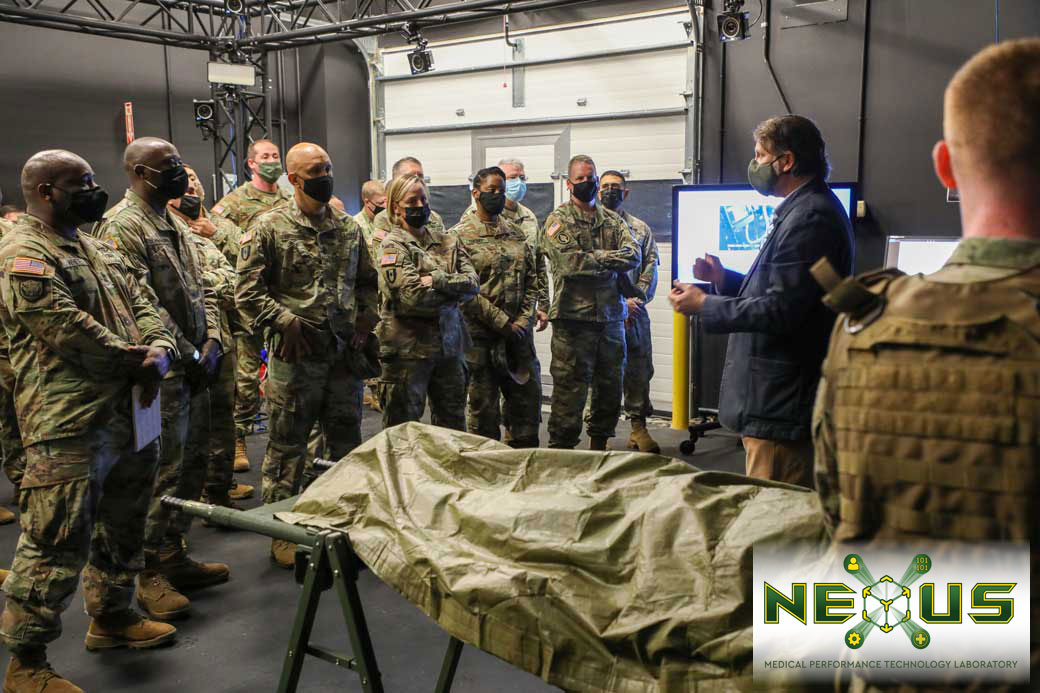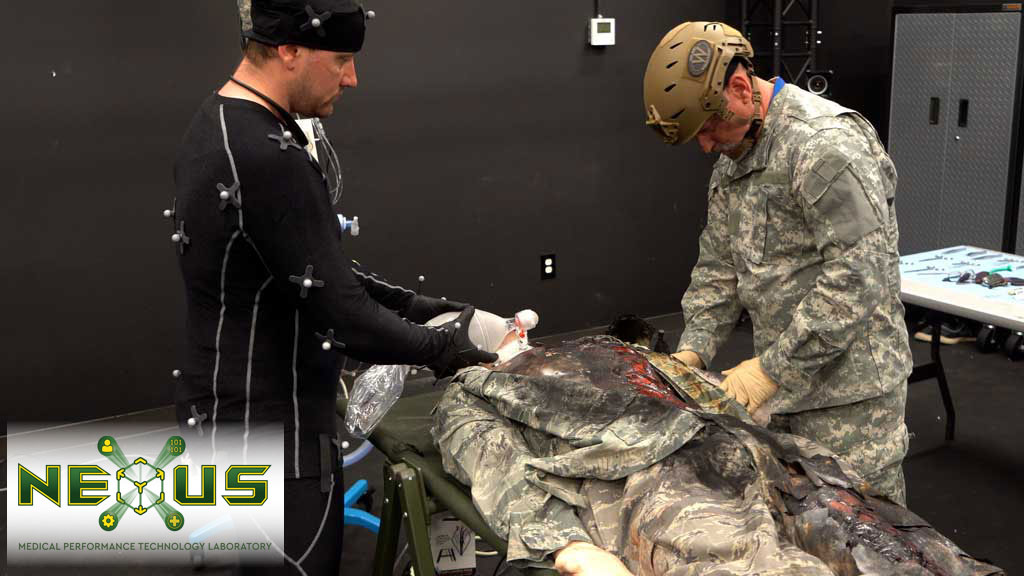TATRC’s MMSIV Introduces its New, State-of-the-Art NEXUS
March 31, 2021 | Download PDF
TATRC has recently developed a new research environment, the NEXUS laboratory. The NEXUS is a high-technology medical performance measurement laboratory, designed to explore, analyze and understand the intersection of humans, data and technology within and across the Military Health System (MHS). This new lab combines a range of state-of-the-art technologies (motion/volume capture, with synchronized psychophysiological monitoring) to record military medical professionals performing medical tasks and procedures to better understand clinical procedural performance, use and impacts of medical devices and technologies, and data and visualization tools with current and future technologies in combat casualty care by individuals and teams. Data derived from the NEXUS laboratory enables research into how current or new procedures, medical devices, robotics, autonomous, and digital health technologies impact caregiver performance in military operational medicine contexts. By establishing baseline medical performance of medics, physician assistants, nurses, doctors, and even infantrymen who provide care to simulated casualties in a laboratory setting that can replicate the spectrum of casualties and illnesses across a range of austere and operational environments (AOEs), we can study how technologies augment or degrade performance and what perspectives caregivers, and someday patients, have about replacing aspects of human care with machine care. By studying technology in this unique laboratory setting first, we can more rapidly identify products likely to help caregivers complete their mission instead of hindering it like many medical technologies currently do today, especially when faced with the constraints of the AOE.

The NEXUS laboratory combines motion capture technology along with physiological monitoring to create accurate models of expert performers. The NEXUS laboratory utilizes both optical motion tracking for gross motor movements and electromagnetic motion tracking for the finer movements, like finger articulation inside a chest cavity. In talking about the creation of the NEXUS laboratory, Geoffrey Miller, Division Chief of Medical Modeling, Simulation, Informatics, and Visualization (MMSIV) said, “while there are plenty of experts who can teach the guidelines for specific medical procedures, there are no objective models showing ‘what right looks like.’”
Along with tracking physical movement, participants can be monitored by a myriad of different physiological monitors. The NEXUS laboratory will utilize an Electroencephalogram (EEG) to measure the electrical activity of the brain. By averaging these electrical responses to stimuli presented to the participant, an objective measure of cognitive load and event related potentials can be measured. This will allow the researcher to know when a participant is experiencing stress or a heavier workload and the ability to pinpoint specific tasks in a procedure that consistently cause the highest cognitive load.
In addition to EEG monitoring, the NEXUS laboratory will use eye tracking technologies. By understanding where the eye fixates when performing a task, researchers can understand what expert performers view as critical information to focus on during specific tasks. Using the eye tracking system, researchers can determine what the experts need to focus on when performing these difficult tasks. Are these experts actually focusing on something that current training methods overlook?
The NEXUS laboratory also incorporates the ability to record other physiological responses such as heart rate, blood pressure, respiratory response, and electrodermal activity (sweat production). By monitoring these responses, the researchers will be able to quantify and describe actions that expert performers involuntarily do that novices would not know to do. Capturing and synchronizing these measures to the motion capture data, researchers can also find specific biophysiological strategies that experts employ, and which are not easily taught.

In creating models of expert performance of a procedure or assessing the impact of new procedures, tools and technologies, military and civilian medical professionals will come into the lab and don all the sensors and equipment. With the motion capture system, researchers can start to find answers to specific ways that medical professionals must position their body to do the procedure. Alternatively, researchers would also be able to see if specific body positions, which are currently taught to be important, are not actually as important to the success of a procedure.
Not only does the NEXUS laboratory aim to accurately model what current procedures look like, there is also a need to understand how changes to the status quo alter the model. The NEXUS laboratory provides the ability to insert new technologies, clinical practice guidelines, or other novel technologies and performance adjuncts and see how they directly affect military medical professionals and, ultimately, the casualties they care for. By getting a better understanding of both the current and potential future states of combat casualty care, the NEXUS laboratory aims to refine both current practices, as well as investigate new innovations aimed at improving military medical care.
For more information on this project, please contact Mr. Geoffrey Miller, geoffrey.t.miller4.civ@mail.mil.
This article was published in the July 2021 issue of the TATRC Times.